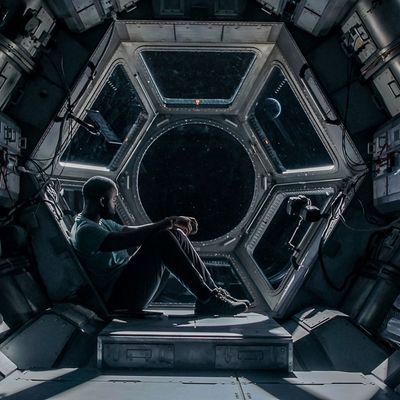
The bravura opening sequence of the new Netflix science-fiction thriller Stowaway presents a model of both artistry and economy, as we watch the launch of a three-person space mission from inside their small cockpit. All the drama lies in the sound — in the rattling frame of the ship around them, the roar of the engines behind them, the jostling of the seats beneath them, and the matter-of-fact voice of mission control coming through on the radio. It’s also in what we maybe don’t hear: At one point, the team’s leader, Commander Barnett (Toni Collette), says that she suspects the “main engines are underperforming slightly,” and suddenly, we’re intently listening in, as if we might hear it, too. Never mind that we wouldn’t know what the hell such slight underperformance might even sound like; as far as we’re concerned, we’re still inside an amazingly loud, amazingly fast, amazingly powerful rocket shooting up beyond the mesosphere.
That little moment exemplifies the ways in which Stowaway, at its best, works on its audience. The film’s plot isn’t particularly complicated, but the particulars of the story often turn on scientific and aeronautic details that aren’t always clear. Luckily, the emotions usually are: Director Joe Penna (who wrote the script with Ryan Morrison) excels at making us pay close attention to the things that do matter, a valuable skill for a movie filled with astronaut jargon and all sorts of twists and turns about this or that contraption working or not working.
Besides Barnett, the mission consists of mild-mannered scientist David (Daniel Dae Kim) and vivacious physician Zoe (Anna Kendrick).
They’re on a two-year mission to Mars, where they will presumably do a variety of experiments on the feasibility of life on the Red Planet. The vessel they inhabit is tethered to an elaborate mechanism spinning rapidly through space, presumably to provide them with gravity. The science behind this arrangement is never fully explained (or if it is, I missed it), but still, we get it. Spinning spaceship. Two years. Three people. Mars. Experiments. Something about algae.
However, the film is called Stowaway, so yeah, there’s a stowaway: Michael (Shamier Anderson), a launch-support crew member and structural engineering graduate student who somehow wound up injured and unconscious before takeoff, and whose body rolls out of a ceiling panel early in the mission. True to form, the movie never quite adequately explains how in the hell some dude wound up accidentally passed out prelaunch inside a ceiling panel on a highly sensitive mission. But director Penna gracefully dances around such challenges. Just about every confusing plot point is overcome by a powerful human moment. So, upon waking up, Michael has a panic attack for the ages when he realizes that he’s on a fucking spaceship headed for Mars. And we’re right there with him: Anderson so effectively conveys Michael’s sudden, catastrophic fear that when he starts rapidly gasping in horror, we might find ourselves similarly struggling to breathe.
The presence of this unexpected fourth person presents a problem on such a delicate journey. There’s only enough oxygen on the ship for three people. We are told that originally it was only enough for two people, but some last-second modifications made the vessel just barely suitable for three. (Again: What?) There’s also no turning back, or any chance of an outside rescue mission. Thus, even as the small crew starts bonding with Michael, and asking him to help out with various “grunt work,” they also start contemplating how they will break the news to him that he might have to, well, die.
There’s allegorical power, of course, in the notion of a group of people whose lives and seemingly lofty purpose are upended by the presence of an unintended refugee who they worry will deprive them of precious resources. While that idea certainly lingers in the air, Stowaway doesn’t seem too interested in metaphor or message — perhaps because its premise turns on so many unclear developments.
Penna keeps the film focused on the people: Each member of the crew responds to the situation differently, and there’s power in watching their differing personalities clash. The cast keeps things admirably grounded as well. Kendrick’s earnestness plays off against Kim’s practicality. Collette, the queen of reaction shots, looks on and mulls her options in gathering horror, anxiety, and despair. Anderson strikes a touching balance between guilt, disbelief, and sorrow.
All that goes far — but it can only go so far. As the crew attempts to find ways around the seemingly insurmountable problem of having too many people and not enough oxygen, don’t be surprised if you find yourself losing the narrative thread amid all the explanations and the acronyms. The film’s central tension, between hand-wavingly vague science and the contagious immediacy of the characters’ emotions, becomes most pronounced during the final act, which is somehow both impressively suspenseful and frustratingly confusing. Still, Stowaway is never boring, even as it leaves you with a million unanswered space questions.


